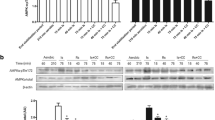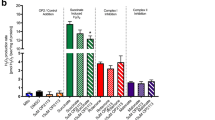Abstract
Defining the substrate that influences the most favourably the myocardial post-ischemic recovery is subject of debates, due to dissociation between functional and biochemical benefits. Hence, we studied the effects of either glucose or different fatty acids on the functional and metabolic recovery of post-ischemic cardiomyocytes in a substrate-free hypoxia model of simulated ischemia-reperfusion. Rat cardiomyocytes were submitted to a 2.5 h simulated ischemia followed by a 2 h reoxygenation without substrate (control), or with either glucose, octanoic acid, oleic acid, or elaidic acid. During simulated ischemia, electromechanical function gradually disappeared while the cellular viability and mitochondrial function declined. During control simulated reperfusion, cardiomyocytes recovered near normal function but a significant reduction in the action potential amplitude and rate persisted. The addition of glucose or oleic acid during simulated reperfusion promoted a faster, better and sustain functional recovery. Amongst the fatty acids, the functional recovery was slower with elaidic and octanoic acids as compared with oleic acid. The mitochondrial function was better improved during simulated reperfusion with glucose than with the tested fatty acids, among which elaidic acid was the less unfavourable. Paradoxically, the addition of whichever substrate during simulated reperfusion tended to worsen the cellular viability. Thus, cardiomyocytes recovery strongly relies on the characteristics of the substrate supplied at the onset of simulated reperfusion: glucidic or lipidic nature, chain-length, insaturation degree. Moreover, these data suggest that defining the appropriateness of a given substrate for the post-ischemic cardiomyocyte recovery is closely related to the functional and the biological endpoints in consideration.
Similar content being viewed by others
Abbreviations
- AP:
-
action potential amplitude
- APD40 and APD80:
-
action potential duration at 40 and 80% of repolarization
- APR:
-
action potential rate
- CD20:
-
contraction duration at 20% relaxation
- CD80:
-
contraction duration at 80% relaxation
- Cmax:
-
relaxation time from 20% to 80% relaxation
- LDH:
-
lactate dehydrogenase
- MTT:
-
3-(4.5-dimethylthiazol-2-yl)-2,5-diphenyl tetrazolium bromide
- tC80:
-
time to peak contraction
References
Opie LH: The Heart (Physiology Metabolism), 2nd edn., Raven Press, New York, 1991, pp. 18–26
Hearse DJ, Humphrey SM, Bullock GR: The oxygen paradox and the calcium paradox; two facets of the same problem? J Mol Cell Cardiol 13: 265–282, 1978
Piper HM, Garciadorado D, Ovize M: A fresh look at reperfusion injury. Cardiovasc Res 38: 291–300, 1998
Opie LH, Sack MN: Metabolic plasticity and the promotion of cardiac protection in ischemia and ischemic preconditioning. J Mol Cell Cardiol 34: 1077–1089, 2002
Stanley WC, Lopaschuk GD, Hall JL, Mccormack JG: Regulation of myocardial carbohydrate metabolism under normal and ischaemic conditions – potential for pharmacological interventions. Cardiovasc Res 33: 243–257, 1997
Dyck JR, Cheng JF, Stanley WC, Barr R, Chandler MP, Brown S, Wallace D, Arrhenius T, Harmon C, Yang G, Nadzan AM, Lopaschuk GD: Malonyl coenzyme a decarboxylase inhibition protects the ischemic heart by inhibiting fatty acid oxidation and stimulating glucose oxidation. Circ Res 94: e78–84, 2004
Neely JR, Grotyohann LE: Role of glycolytic products in damage to ischemic myocardium. Circ Res 55: 816–824, 1984
Tani M, Shinmura K, Ebihara Y, Asakura Y: Inhibition of glycolysis or increased perfusate H+ buffering capacity, but not their combination, attenuates myocardial stunning. Cardiovasc Res 27: 1645–1650, 1993
Tran L, Kucera P, Deribaupierre Y, Rochat AC, Raddatz E: Glucose is arrhythmogenic in the anoxic-reoxygenated embryonic chick heart. Pediatr Res 39: 766–773, 1996
Van de Velde M, DeWolff M, Leather HA, Wouters PF: Effects of lipids on the functional and metabolic recovery from global myocardial stunning in isolated rabbit hearts. Cardiovasc Res 48: 129–137, 2000
Löster H, Punzel M: Effects of L-carnitine on mechanical recovery of isolated rat hearts in relation to the perfusion with glucose and palmitate. Mol Cell Biochem 185: 65–75, 1998
Kehrer J, Park Y, Sies H: Energy dependence of enzymes release from hypoxic isolated perfused rat heart tissues. J Appl Physiol 65: 1855–1860, 1988
Yamane Y, Ishide N, Kagaya Y, Takeyama D, Shiba N, Chida M, Nozaki T, Takahashi T, Ido T, Shirato K: Heterogeneous fatty acid uptake early after reperfusion in rat hearts. Am J Physiol 43: H923–H929, 1998
Tirosh R, Mishor T, Pinson A: Glucose is essential for the initiation of fatty acid oxidation in ATP-depleted cultured ventricular myocytes. Mol Cell Biochem 162: 159–163, 1996
Schjott, J, Bakoy OE, Jones RA, Southon T, Jynge P: Preconditioning by brief ischaemic episodes in the isolated rat heart assessed by P-31 NMR spectroscopy: Dissociation between metabolic and functional recovery? Scand J Clin Lab Invest 55: 67–78, 1995
Athias P, Grynberg A: Electrophysiological studies on heart cells in culture. In: A. Pinson (eds.) The Heart Cells in Culture, Vol. 1. CRC Press, Boca Raton, USA, pp 125–158, 1987
Grynberg A, Athias P, Degois M: Effect of change in growth environment on cultured myocardial cells investigated in a standardized medium. In vitro Cell Dev Biol 22: 44–50, 1986
Fantini E, Athias P, Courtois M, Khatami S, Grynberg A, Degois M: Oxygen and substrate deprivation on isolated rat cardiac myocytes: Temporal relationship between electromechanical and biochemical consequences. Can J Physiol Pharmacol 68: 1148–1156, 1990
Fantini E, Athias P, Courtois M, Grynberg A: A simple gas-flow chamber for cultured cell electrophysiology in a controlled atmosphere. Eur J Physiol 409: 632–634, 1987
Tissier C, Bes S, Vandroux D, Fantini E, Rochette L, Athias P: Specific electromechanicals responses to individual and combined components of ischemia. Can J Physiol Pharmacol 80: 1–13, 2002
Grynberg A, Fantini E, Athias P, Degois M, Guenot L, Courtois M, Khatami S: Modification of the n-6/n-3 fatty acid ratio in the phospholipids of rat ventricular myocytes in culture by use of synthetic media; functional and biochemical consequences in normoxic and hypoxic conditions. J Mol Cell Cardiol 20: 863–874, 1988
Athias, P, Groz B, Surville JM, Klepping J: Simultaneous record of mechanical and electrical activities of rat heart cells in culture. Biol Cell 37: 131–136, 1980
Gomez LA, Alekseev AE, Aleksandrova LA, Brady PA, Terzic A: Use of MTT assay in adult ventricular myocytes to assess viability: Effects of adenosine and potassium on cellular survival. J Mol Cell Cardiol 29: 1255–1266, 1997
Chevalier A, Demaison L, Grynberg A, Athias P: Influence of the phospholipid polyunsaturated fatty acid composition on some metabolic disorders induced in rat cardiomyocytes by hypoxia and reoxygenation. J Mol Cell Cardiol 22: 1177–1186, 1990
Reimer KA, Tanaka M, Murry CE, Richard VJ, Jennings RB: Evaluation of free radical injury in myocardium. Toxicol Pathol 18: 470–480, 1990
Durot I, Maupoil V, Ponsard B, Cordelet C, Vergely-Vandriesse C, Rochette L, Athias P: Oxidative injury of isolated cardiomyocytes: Dependence on free radical species. Free Radic Biol Med 29: 846–857, 2000
Apstein CS: Increased glycolytic substrate protection improves ischemic cardiac dysfunction and reduces injury. Am Heart J 139: 107–114, 2000
Diaz R, Paolasso A, Piegas LS, Tajer CD, Moreno MG, Corvalan R, Isea JE, Romero G: Metabolic modulation of acute myocardial infarction: The ECLA glucose-insulin-potassium pilot trial. Circulation 98: 2227–2234, 1998
Lopaschuk GD, Belke DD, Gamble J, Itoi T, Schonekess BO: Regulation of fatty acid oxidation in the mammalian heart in health an disease. Biochim Biophys Acta 1213: 263–276, 1994
Oliver MF, Opie LH: Effects of glucose and fatty acids on myocardial ischaemia and arrhythmias. Lancet 343: 155–158, 1994
Liedtke AJ, Demaison L, Eggleston AM, Cohen LM, Nellis SH: Changes in substrate metabolism and effects of excess fatty acids in reperfused myocardium. Circ Res 62: 535–542, 1988
Theroux P: Protection of the myocardial cell during ischemia. Am J Cardiol 83: 3–9, 1999
Aasum, E, Hafstad A D, Larsen TS: Changes in substrate metabolism in isolated mouse hearts following ischemia-reperfusion. Mol Cell Biochem 249: 97–103, 2003
Van de Velde M, DeWolff M, Leather HA, Wouters PF: Effects of lipids on the functional and metabolic recovery from global myocardial stunning in isolated rabbit hearts. Cardiovasc Res 48: 129–137, 2000
Hart BJ, Bian XM, Mallet RT, Downey HF: Hyperlipidemia with hypoglycemia reduces myocardial oxygen utilization efficiency but not contractile function during coronary hypoperfusion. J Mol Cell Cardiol 32: 1539–1552, 2000
Montessuit C, Papageorgioou I, Tardy-Cantalupi I, Rosenblatt-Velin N, Lerch R: Post-ischemic recovery of heart metabolism and function: Role of mitochondrial fatty acid transfer. J Appl Physiol 89: 111–119, 2000
Lewandowski ED, Kudej RK, White LT, ODonnell JM, Vatner SF: Mitochondrial preference for short chain fatty acid oxidation during coronary artery constriction. Circulation 105: 367–372, 2002
Zanotti G: Muscle fatty acid-binding protein. Biochim Biophys Acta 1441: 94–105, 1999
Lichtenstein AH, Schwab US: Relationship of dietary fat to glucose metabolism. Atherosclerosis 150: 227–243, 2000
De Vries JE, Vork MM, Roemen THM, Dejong YF, Cleutjens JPM, Van der Vusse GJ, Vanbilsen M: Saturated but not mono-unsaturated fatty acids induce apoptotic cell death in neonatal rat ventricular myocytes. J Lipid Res 38: 1384–1394, 1997
Stender S, Dyerberg J: Influence of trans fatty acids on health. Ann Nutr Metab 48: 61–66, 2004
Frelin C: Glucose and palmitate metabolism by beating rat heart cells in culture. Path Biol 27: 45–50, 1979
Schjott J, Bakoy OE, Jones RA, Southon T, Jynge P: Preconditioning by brief ischaemic episodes in the isolated rat heart assessed by P-31 NMR spectroscopy: Dissociation between metabolic and functional recovery? Scand J Clin Lab Invest 55: 67–78, 1995
McCarty MF: A shift in myocardial substrate, improved endothelial function, and diminished sympathetic activity may contribute to the anti-anginal impact of very-low-fat diets. Med Hypothesis 62: 62–71, 2004
Van Bilsen M, Smeets PJ, Gilde AJ, Van der Vusse GJ: Metabolic remodelling of the failing heart: The cardiac burn-out syndrome? Cardiovasc Res 61: 218–226, 2004
Author information
Authors and Affiliations
Corresponding author
Rights and permissions
About this article
Cite this article
Tissier, C., Vandroux, D., Devillard, L. et al. Substrate dependence of the postischemic cardiomyocyte recovery: Dissociation between functional, metabolic and injury markers. Mol Cell Biochem 273, 43–55 (2005). https://doi.org/10.1007/s11010-005-7375-4
Received:
Accepted:
Issue Date:
DOI: https://doi.org/10.1007/s11010-005-7375-4




